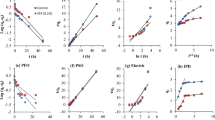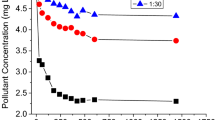Abstract
Adsorption of sulfosulfuron was studied in two soils (topsoil from Alfisol and Inceptisol). The adsorption of sulfosulfuron was greater in topsoil collected from Alfisol than in Inceptisol. The soil sorption coefficient K and the soil organic carbon sorption coefficient K oc are the basic parameters used for describing the environmental fate of the herbicides. In topsoil the calculated K values from Alfisol was 4.43 and in topsoil from Inceptisol was 2.00. K c values were 6.06 in topsoil from Alfisol and 3.33 in topsoil from Inceptisol. The K oc values were 886.36 in topsoil from Alfisol and 770.26 in topsoil from Inceptisol. Field experimental plots with no previous history of sulfosulfuron were selected and studied the degradation of sulfosulfuron in the topsoil collected from Alfisol and Inceptisol. The half-life of sulfosulfuron in topsoil from Alfisol: T 1− 3.97 days and T 2− 4.54 days; topsoil from Inceptisol: T 1 − 4.68 days and T 2 − 5.52 days. The degradation of sulfosulfuron followed first-order kinetics. The persistence of sulfosulfuron was found relatively longer in the Inceptisol than in Alfisol. The combination of degradation data (t 1/2 – soil) and organic carbon based sorption (K oc) data of herbicides have been used to assess the pesticide environmental impact in soils through Gustafson Ubiquity Score (GUS). The GUS values were found to be 0.69 in topsoil from Alfisol and 0.83 in Inceptisol.
Similar content being viewed by others
References
Braverman, M.P., Dusky, J.A., Locascio, S.J., & Hornsby, A.G. (1990). Sorption and degradation of thiobencarb in three Florida soils. Weed Science, 38, 583–588.
Beyer, E.M., Duffy, M.J., Hay, J.V., & Schlueter, D.D. (1988). Sulfonylureas. In: P.C. Kearney, & D.D. Kaufman (Eds.), Herbicides chemistry, degradation and mode of action (Vol. 3, pp. 117–189). New York: Marcel Dekker.
Eleftherohorinos, I., Dhima, K., & Vasilakoglou, I. (2004). Activity, adsorption, mobility and field persistence of sulfosulfuron in soil. Weed Science, 32(3), 274–285.
Gustafson, D.I. (1989). Groundwater ubiquity score: A simple method for assessing pesticide leachability. Environmental Toxicology and Chemistry, 8, 339–357.
Hurle, K., & Walker, A. (1980). Persistence and its prediction. In: R.J. Hance (Ed.), Interactions between herbicides and the soil (pp. 83–122). New York: Academic Press.
Kelley, J.P., & Peeper, T.F. (2003). Wheat ( Triticum aestivum) and rotational crop response to MON 37500. Weed Technology, 17, 55–59.
Miller, P.A., Westra, P., & Nissen, S.J. (1999). The influence of surfactant and nitrogen on foliar absorption of MON 37500. Weed Science, 47, 270–274.
Mersie, W., & Foy, C.L. (1985). Phytotoxicity and adsorption of chlorsulfuron as affected by soil properties. Weed Science, 33, 564–568.
Mersie, W., & Foy, C.L. (1986). Adsorption, desorption and mobility of chlorsulfuronas in soils. Journal of Agricultural and Food Chemistry, 34, 89–92.
Parrish, S.K., Kaufman, J.E., Croon, K.A., Ishida, Y., Ohta, K., & Ioth, S. (1995). MON 37500: A new selective herbicide to control annual and perennial weeds in wheat. Br. Crop Prot. Conf. Weeds, 3, 1127–1132.
Pesticide Manual. (2003). Thirteenth Edition. BCPC Publications, pp. 913–914.
Pionke, H.B., & De Angelis, R.J. (1980). Method for distributing pesticide loss in field runoff between the solution and adsorbed phase. In: CREAMS. A field scale model for chemicals runoff and erosion from Agricultural Management systems. USDA Conservation Research Report. 26.USDA, SEA, Washington DC, pp. 607–643.
Pusino, A., Fiori, M.G., Braschi, I., & Gessa, C. (2003). Adsorption and desorption of triasulfuron by soil. Journal of Agricultural and Food Chemistry, 51(18), 5350–5354.
Saha, S., Yaduraju, N.T., & Kulshrestha, G. (2003). Residue studies and efficacy of sulfosulfuron in wheat crop. Pesticide Research Journal, 15(2), 173–175.
Saha, S., & Kulshrestha, G. (2002). Degradation of sulfosulfuron, a sulfonylurea herbicide, as influened by abiotic factors. Journal of Agricultural and Food Chemistry, 50(16), 4572–4575.
Sarmah, A.K., Kookana, R.S., & Alston, A.M. (1998). Fate and behavior of the three sulfonylurea herbicides such as triasulfuron, metsulfuron-methyl and chlorsulfuron in Australian soil environment. Australian Journal of Agricultural Research, 49, 775–790.
Shinn, S.L., Thill, D.C., Price, W.J., & Ball, D.A. (1998). Response of downy brome (Bromus tectorum) and rotational crops to MON 37500. Weed Technology, 12, 690–698.
Author information
Authors and Affiliations
Rights and permissions
About this article
Cite this article
Maheswari, S.T., Ramesh, A. Adsorption and degradation of sulfosulfuron in soils. Environ Monit Assess 127, 97–103 (2007). https://doi.org/10.1007/s10661-006-9263-0
Received:
Accepted:
Published:
Issue Date:
DOI: https://doi.org/10.1007/s10661-006-9263-0




